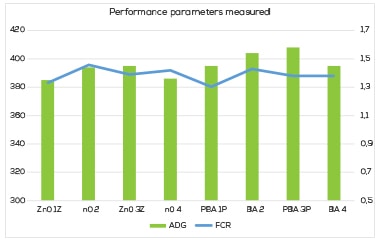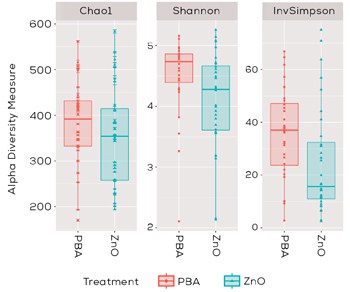“The European Commission has decided to ban the use of high dose of ZnO in feed from June 2022. In this regard, new dietary strategies in weaning transition are needed. Among feeding strategies (decreasing crude protein level, fiber types and percentage of inclusion, high quality ingredients), organic acids (OA) are a valuable tool.”

Sr. Tech. Manager.
Novus Europe S.A./N.V.
Commercial piglets weaning implies sharp changes of the intestinal morphology and commensal gut microbiota. These changes can predispose piglets to post-weaning diarrhoea (PWD). It is well known PWD is a complex and multifactorial process in which the intestinal ecosystem plays a key role. In fact, the disruption of the microbiota is referred as dysbiosis and can be accompanied by colonization by pathogenic bacteria: this imbalance is normally identified by a decrease in bacteria of the Lactobacillus group, loss of microbial diversity and an increase of the relative abundance of enterobacteria.
Dietary zinc oxide (ZnO) used at pharmacological dose (2.5-3 g/kg) is largely being used as an efficient tool in the post-weaning phase to reduce the incidence of PWD in most European countries. However, it has been demonstrated there is a strong correlation between the use of ZnO in pig diets and accumulation of Zn in the environment and there is evidence that high levels of ZnO may co-select antibiotic-resistant microorganism too.
With this scenario and based on advice from the European Medicines Agency, the European Commission has decided to ban the use of high dose of ZnO in feed from June 2022. In this regard, new dietary strategies in weaning transition are needed. Among feeding strategies (decreasing crude protein level, fiber types and percentage of inclusion, high quality ingredients), organic acids (OA) are a valuable tool.
Indeed, the use of benzoic acid, formic acid and its salts are associated to several beneficial effects on growth performance of pigs. In their free form OA act as acidifiers, by dissociating and lowering the pH, reducing, or eliminating the pathogenic bacteria usually sensitive to low pH in upper gastrointestinal tract. When coating or embedding technology is used, the stability and bioavailability of OA are increased, and it is ensured their release throughout all the gastrointestinal tract.
OUR FIELD TRIAL: DESCRIPTION
To explain some of the above-mentioned points, a trial was designed. The objective of the trial was to study the effect of a combination of embedded aromatic compounds, including among other benzoic acid, in a fat matrix (from Novus International, Inc.) on growth performance and faecal microbial profile of piglets in field conditions as replacement of ZnO added at high dose.
The field trial was run in collaboration with the Universidad Complutense de Madrid. In the trial, a total of 3448 piglets reared in 4 commercial farms located in Spain were assigned to two treatments based on their initial body weight (BW) and sex:
i) a commercial diet supplemented with 2.5 g/kg of zinc oxide (ZnO, 1720 piglets) or
ii) the same basal diet but including 2.5 g/kg of a commercial product that is a combination of embedded aromatic compounds, including among other benzoic acid, in a fat matrix (PBA 1728 piglets,).
All the farms selected were using routinely ZnO at pharmacological dose. The animals received the treatments for a total of 6 weeks (4 weeks during suckling and 2 weeks after weaning).
Cumulative performance from weaning to 6 weeks post-weaning were calculated and fresh faeces for each one of the farms (8 replicates per group) were taken at the end of the experimental period. The bacterial DNA was isolated and extracted and the V3-V4 region of the 16S rRNA gene was amplified and sequenced by the University of Bologna.

WHAT DID WE FIND?
Piglets receiving PBA showed higher daily gain (ADG, P <0.01) and lower feed conversion ratio (FCR, P <0.05) in all the farms compared to ZnO. Also, it was observed a reduction of mortality and diarrhoea incidence in pigs from the PBA compared the ZnO (P <0.01): see Figure 1.
![]() In addition to these changes in performance, we also observed changes in gut microbiota.
In addition to these changes in performance, we also observed changes in gut microbiota.

Faecal microbiota was characterized by a higher alpha diversity in the PBA treatment . The alpha diversity plot (Figure 2) showed a higher microbial diversity in the PBA group compared with the ZnO group. A higher diversity is considered a marker for a more balanced, healthier, and mature microbiota. Fact that could be behind the improvements we observed on performance.
The microbial composition was also influenced by treatment (P <0.01). Piglets receiving PBA showed higher abundance of Ruminococcus (P <0.01), Prevotellaceae (P <0.01) and Fibrobacteraceae (P <0.05).
These results support the hypotheses that in in field conditions the supplementation of 2.5 g/Kg of an embedded benzoic acid can replace pharmacological doses of zinc oxide, maintaining the growth performance of piglets and shifting the faecal microbiota profile.
Indeed, it has been reported that Ruminococcus, Prevotella and Fibrobacter can improve the fermentation of dietary polysaccharides and the production of SCFAs, which are known to exert beneficial function for the host. The SCFAs exert several physiological functions, as precursors for energy, reducing intestinal inflammation and the gut permeability and the consequent risk of bacterial translocation. In addition, the positive effect on the gut mucosa integrity favours the absorptive capacity of intestine, with positive effects on feed efficiency.
On the other hand, ZnO supplemented pigs had a higher abundance of Bacteroidaceae. This bacterial group characterizes the pre-weaning phase in piglets: this again supports the hypothesis that the PBA group could have a healthier and more mature microbiota structure compared with the ZnO group.
![]() OUR FINAL MESSAGE
OUR FINAL MESSAGE
In conclusion, the supplementation of piglets’ diets with a blend of protected aromatic compounds including benzoic acid positively shifted the microbial profile of weaned piglets compared to a pharmacological dose of ZnO by increasing microbiota diversity. In addition, PBA supplementation increased the proliferation of bacteria involved in fiber utilization and feed efficiency. This finding in parallel with the observed improvement of growth performance and the reduction of diarrhoea incidence suggests the possibility to replace ZnO with the tested blend of protected aromatic compounds in nursery pigs.
About Marisol Castillo
Marisol has a degree on Veterinary Science 2001 and a PhD on Animal Nutrition (2006). After her PhD, she started to work as a nutritionist and since then has been involved in different areas of the Industry, as a product manager and R&D manager, always focused on improving animal health on monogastric animals. Since 2016 she works in Novus as Senior Technical Services Manager for Swine in North Europe.